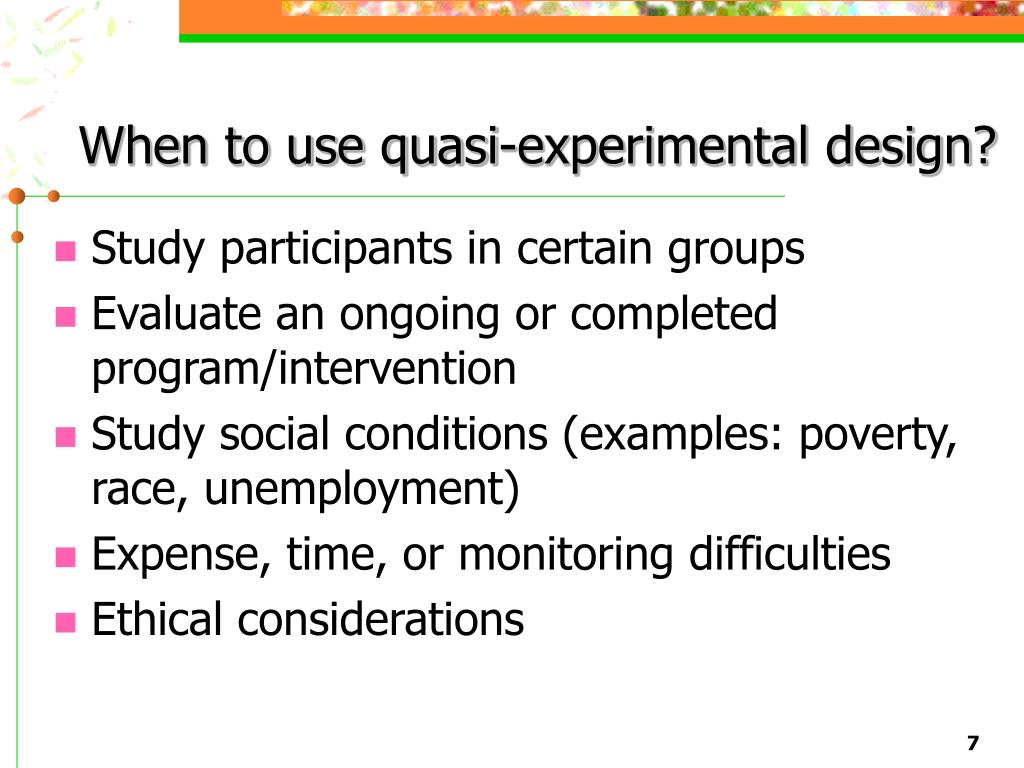Table Of Content

Unfortunately, this study design is often used in medical informatics when new software is introduced since it may be difficult to have pretest measurements due to time, technical, or cost constraints. In this paper, we review the different pretest-posttest quasi-experimental study designs, their nomenclature, and the relative hierarchy of these designs with respect to their ability to establish causal associations between an intervention and an outcome. The example of a pharmacy order-entry system aimed at decreasing pharmacy costs will be used throughout this article to illustrate the different quasi-experimental designs. The outcome (neonatal mortality) for each household was available at points in time that could be related to the inception of the program. Unfortunately, comparison group data were not available for nonparticipants, so an analysis of secular trends due to general improvements in maternal and child health care (i.e., not due to SDIP) was not possible. But ultimately, due to the lack of comparison group data, the authors themselves note that the study is only able to provide “plausible evidence of an impact” rather than probabilistic evidence (p. 224).
Employ a model or framework that covers both internal and external validity
This kind of experiment would raise ethical concerns since the participants assigned to the treatment group are required to eat junk food against their will throughout the experiment. This design involves selecting participants based on a specific cutoff point on a continuous variable, such as a test score. Participants on either side of the cutoff point are then compared to determine whether the intervention or event had an effect. Accident data is collected over several months before and after the regulation’s implementation. By analyzing trends in accident frequency, researchers can assess whether the intervention had a significant impact. An alternative explanation that refers to how the participants might have changed between the pretest and posttest in ways that they were going to anyway because they are growing and learning.
Ethical Reasons
For example, a bowler with a long-term average of 150 who suddenly bowls a 220 will almost certainly score lower in the next game. Regression to the mean can be a problem when participants are selected for further study because of their extreme scores. Imagine, for example, that only students who scored especially low on a test of fractions are given a special training program and then retested.
Regression discontinuity
The checklist shows that credible quasi-experimental studies gain credibility from using high-quality longitudinal/panel data; such data characterizing health care are rare, leading to evaluations that “make do” with the data that are available in existing information systems. The advantage of this design is that it demonstrates reproducibility of the association between the intervention and the outcome. For example, the association is more likely to be causal if one demonstrates that a pharmacy order-entry system results in decreased pharmacy costs when it is first introduced and again when it is reintroduced following an interruption of the intervention. As for design A5, the assumption must be made that the effect of the intervention is transient, which is most often applicable to medical informatics interventions.
This design can be useful for determining whether the intervention or event had an effect, but it does not allow for control over other factors that may have influenced the outcomes. The quality of causal evidence presented in this study is low because the authors did not ensure that the groups being compared were similar before the intervention. This means we are not confident that the estimated effects are attributable to financial education in the workplace; other factors are likely to have contributed.
Natural Experiments

However, because the two groups are nonequivalent (assignment to the groups is not by randomization), selection bias may exist. Selection bias exists when selection results in differences in unit characteristics between conditions that may be related to outcome differences. For example, suppose that a pharmacy order-entry intervention was instituted in the MICU and not the SICU. If preintervention pharmacy costs in the MICU (O1a) and SICU (O1b) are similar, it suggests that it is less likely that there are differences in the important confounding variables between the two units. If MICU postintervention costs (O2a) are less than preintervention MICU costs (O1a), but SICU costs (O1b) and (O2b) are similar, this suggests that the observed outcome may be causally related to the intervention.
Data Analysis Methods
Also, the absence of pretest measurements comparing the SICU to the MICU makes it difficult to know whether differences in O1 and O2 are due to the intervention or due to other differences in the two units (confounding variables). Specifically, we describe four quasi-experimental designs – one-group pretest–posttest designs, non-equivalent group designs, regression discontinuity designs, and interrupted time-series designs – and their statistical analyses in detail. Both simple quasi-experimental designs and embellishments of these simple designs are presented.
Quasi-experimental Designs That Use a Control Group but No Pretest
(PDF) A Program for Parents' Screen Time Reduction for Preschool Children: A Quasi-experimental Study - ResearchGate
(PDF) A Program for Parents' Screen Time Reduction for Preschool Children: A Quasi-experimental Study.
Posted: Mon, 07 Aug 2023 01:49:26 GMT [source]
The checklist clarifies the basis of credible quasi-experimental studies, reconciling different terminology used in different fields of investigation and facilitating communications across research communities. By applying the checklist, review authors' attention is also directed to the assumptions underpinning the methods for inferring causality. To conduct a quasi-experiment study like the one mentioned above, researchers can utilize QuestionPro, an advanced research platform that offers comprehensive survey and data analysis tools.
Workplace financial education and change in financial knowledge: A quasi-experimental approach (Horwitz et al.,
In one classic example, the treatment was the reduction of the work shifts in a factory from 10 hours to 8 hours (Cook & Campbell, 1979). As we mentioned before, quasi-experimental research entails manipulating an independent variable by randomly assigning people to conditions or sequences of conditions. Non-equivalent group designs, pretest-posttest designs, and regression discontinuity designs are only a few of the essential types. In a quasi-experimental design, the researcher uses an existing group of participants that is not randomly assigned to the experimental and control groups. Instead, the groups are selected based on pre-existing characteristics or conditions, such as age, gender, or the presence of a certain medical condition. Quasi-experimental methods are used increasingly to evaluate programs in health systems research.
Even though quasi-experimental design has been used for some time, relatively little is known about it. This method involves summarizing the data collected during a study using measures such as mean, median, mode, range, and standard deviation. Descriptive statistics can help researchers identify trends or patterns in the data, and can also be useful for identifying outliers or anomalies. Discover the concept of quasi-experiment, its various types, real-world examples, and how QuestionPro aids in conducting these studies.
An interrupted time-series design is one in which a string of consecutive observations equally spaced in time is interrupted by the imposition of a treatment or intervention. The advantage of this design is that with multiple measurements both pre- and postintervention, it is easier to address and control for confounding and regression to the mean. In the example of a pharmacy order-entry system, O1 through O5 could represent monthly pharmacy costs preintervention and O6 through O10 monthly pharmacy costs post the introduction of the pharmacy order-entry system. Interrupted time-series designs also can be further strengthened by incorporating many of the design features previously mentioned in other categories (such as removal of the treatment, inclusion of a nondependent outcome variable, or the addition of a control group).
Thus, if the efficacy of an intervention has not been established, a randomized controlled trial is the design of choice to determine efficacy. But if the intervention under study incorporates an accepted, well-established therapeutic intervention, or if the intervention has either questionable efficacy or safety based on previously conducted studies, then the ethical issues of randomizing patients are sometimes raised. In the area of medical informatics, it is often believed prior to an implementation that an informatics intervention will likely be beneficial and thus medical informaticians and hospital administrators are often reluctant to randomize medical informatics interventions. In addition, there is often pressure to implement the intervention quickly because of its believed efficacy, thus not allowing researchers sufficient time to plan a randomized trial.
Public health practice involves implementation or adaptation of evidence-based interventions into new settings in order to improve health for individuals and populations. Such interventions typically include on one or more of the “7 Ps” (programs, practices, principles, procedures, products, pills, and policies) (9). Increasingly, both public health and clinical research have sought to generate practice-based evidence on a wide range of interventions, which in turn has led to a greater focus on intervention research designs that can be applied in real-world settings (2, 8, 9, 20, 25, 26, 10, 2). Quasi-experimental research designs are a type of research design that is similar to experimental designs but doesn’t give full control over the independent variable(s) like true experimental designs do. Much like an actual experiment, quasi-experimental research tries to demonstrate a cause-and-effect link between a dependent and an independent variable.
Cells in the table are completed with respect to the thumbnail sketches of the corresponding designs described in Box 1, Box 2. However, because they couldn’t afford to pay everyone who qualified for the program, they had to use a random lottery to distribute slots. Since they couldn't afford to cover every person who qualified for the program, the state used a random lottery to allocate program slots.



















